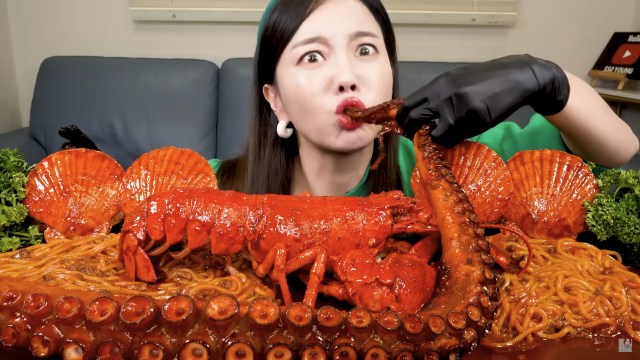How far will someone push themselves to be big in the mukbang community? (Credit: YouTube)

Not long before she died, Pan Xiaoting was rushed to hospital. The morbidly obese 24-year-old “influencer” had gastrointestinal bleeding from an eating challenge, one of many she livestreamed to thousands of fans. Undaunted, though, she was back at the table days later, promising her followers that she would eat 10kg of food in one sitting. The stomach tear which then killed her live on air was inevitable.
What made a young woman eat herself to death in front of legions of viewers? One word: Mukbang. Korean for “eating broadcast”, it’s a trend which slithered out of the early 2010s and has ballooned into popular culture. These videos were an amalgamation of YouTube’s favourite genres: routines (“get ready with me”; “what I eat in a day”), ASMR (splurpy, sizzly, crunchy textural noises), unboxing (testing and reviewing products) and food porn (self-explanatory). They are by turns horrifying and awe-inspiring — often featuring pretty, young Asian women with doll-like makeup slurping up some pretty nauseating victuals. The videos are, inevitably, saturated with pornographic imagery.
For young women, there is a morbid fascination in watching people devour huge quantities of the worst kind of food; I’ll regularly wake up on a hungover Sunday morning to watch Becki Jones and Abby Taylor Bannigan put away three McDeliveries as the kettle boils. It is a sort of liberating abandon for those of us who instinctively look to restrict our diets. My most intense period of viewing was in my first year of university when, limp from my own eating issues, I would lie in bed salivating over videos of cheese, potatoes, cakes, cookies, burgers. That’s the thing about denying yourself food: it is guaranteed to become your primary fixation. Hence the escalating popularity of mukbang; it is deeply rooted in our eating-disordered culture, fuelled by the thrilling sacrilege of bingeing for complex-ridden teenagers. Girls who once trawled Tumblr for Kate Moss quotes now stare through their fingers at TikToks by Plus Size Park Hoppers, who visit the restaurants of Disneyland trying to squeeze into the seats. The flip side is, if anything, more enticing — with genuinely anorexic creators and emaciated models aggressively promoting “clean eating” and sending scores of followers towards recovery clinics.
There is more to mukbang, though, than just teenagers being weird about food. Something different, something supercharged, something powerful enough to set the scene for the death of an otherwise healthy 24-year-old. To find out what’s driving it, just follow the money. Ad revenue from YouTube, or earnings from TikTok’s creator fund, are notoriously low — and ordering all those takeaways is expensive. So who’s footing the bill?
Who else, but horny men with a fat fetish. The internet is awash with “feeder” culture, to the extent that the specialist forum Feabie.com terms it “a sexual orientation, sorta like being straight or bi”. Feeder, as you might have guessed, encourage — or force — “feedees” to eat to the point of immobility or death. Even more extreme versions of feederism involve “vore”: that is, partners eating one another, performing a sort of sadistic obliteration of identity. And these bizarre, hardcore fetishes filter back down into mainstream mukbang: one particularly challenging video I watched was of a women shovelling live octopuses into her mouth, prising tentacles from her face with chopsticks as they fought being gobbled up.
Fetish communities have existed on the fringes since Adam met Eve. But the line between mainstream internet content and gnarlier sex stuff is disappearing: Twitter is awash with OnlyFans models replying to every viral post, while Facebook is flooded with weird “cooking” videos which are Trojan-horsing fetishes into clips your nan might share. And within the mukbang world, men are paying young food bloggers to produce pornified content. If you can treble the revenue from an eating clip by throwing in phrases like “I can feel myself getting bigger…”, why wouldn’t you? It’s a quick, if stomach-churning, way to earn a lot of money.
Enter Jellybeansweets, a 20-year-old American with 1.2 million followers on TikTok. Previously known for her dancing videos, she now prefers gruesomely fast eating sessions, shovelling down burritos the size of her head. She sits there in a tight crop top, slathering her food in sauce and letting it drip all over her face, making slurpy mouth noises and grunting. It’s probably slightly safer than doing sex work proper — but how far will she take it?
Getting paid to do odd and harmful things to make money online is a story as old as time — or as old as Internet Explorer, at least. From the OnlyFans feet pic seller to the Dark Web gore merchant, vulnerable individuals are always poised to sacrifice health for a quick buck. But we, the audience, are as much to blame, egging these grotesques on. We have all become deliciously complicit in the spectacle as every one of our clicks clogs an artery. Witness poor Nicholas Perry, aka Nikocado Avocado, a 32-year-old YouTuber from Pennsylvania, who went from scrawny vegan to 400lb mega-mukbanger in the space of a couple of years, with clips of him screaming in despair surrounded by mountains of junk food going hauntingly viral. Just type “mukbang” into any social media search bar, and a crowd of ecstasy-wracked faces, mouth open wide, emerges. Pan Xiaoting, our mukbang martyr, was once among them – and is now just a stale nugget of internet lore.
The bulging bodies of clinically depressed YouTubers do seem to be a neat metaphor for the overconsumption of capitalist internet culture. But I suspect the popularity of these chumps is simpler than that: as the algorithms simmer our brains, we are pulled to ever more extreme — gross, sexy, extravagant — content. And a critical part of the recipe is loneliness: these videos are totems of our parasocial existences: to pierce the isolation of the internet surfer, we all voyeuristically watch each other do things as traditionally communal as eating.
It is no coincidence that mukbang, this all-consuming trend, sits at the intersection of eating disorders, fetishes and loneliness. A fixation on what goes in the mouths of others speaks to an emptiness, a vortex at the core of modern life. And within this vacuum, the strangest human impulses are blown into obsessions, leaving individuals to scrabble about for connection by anonymously watching one another choke down 20 tostadas. Influencers lose themselves as they amp up their online personas until we, their guilty, gratified audience, have reduced them to rows of fattened ducks, force-fed attention. Mukbangs have a greater reach than any other snuff film — but that is, nevertheless, what they really are. And the worst thing is, we are the assassins. Even the most casual viewer in the world harbours an unexpected compulsion to make foie gras of TikTokers’s livers, and the hungrier their audience, the harder they fall.










Join the discussion
Join like minded readers that support our journalism by becoming a paid subscriber
To join the discussion in the comments, become a paid subscriber.
Join like minded readers that support our journalism, read unlimited articles and enjoy other subscriber-only benefits.
Subscribe